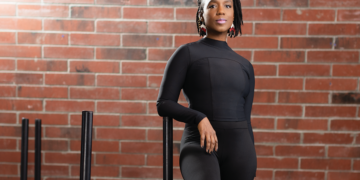For generations, football gave Nebraska a statewide identity. But with Husker gridiron fortunes flagging, volleyball is the new signature sport with booming participation and success.
Here and nationally, more girls now play volleyball than basketball (according to the National Federation of State High School Associations).
“It’s the main or premier sport for women right now,” Doane University coach Gwen Egbert says.
Omaha has become a volleyball showcase. The city hosted NCAA Division I Finals in 2006, 2008, and 2015, with the Cornhuskers competing on all three occasions (winning the national title in 2006 and 2015).
Packed crowds at the CenturyLink Center will once again welcome the nation’s top teams when Omaha hosts the championships in 2020. Meanwhile, Creighton University is emerging as another major volleyball powerhouse, and the University of Nebraska-Omaha has made strides in the Mavericks’ first two years of full Division I eligibility since joining the Summit Conference.
In the 2017 NCAA tournament, Creighton advanced to the second round (but fell to Michigan State). As this edition of Omaha Magazine went to press, the Cornhuskers headed to regionals in hopeful pursuit of a fifth national championship.
“The fact Nebraska has done and drawn so well, and that kids are seeing the sport at a high level at a young age, gets people excited to play,” says Husker legend Karen Dahlgren Schonewise, who coaches for Nebraska Elite club volleyball and Duchesne Academy in Omaha.
The University of Nebraska-Lincoln first reached a national title game with Schonewise in 1986. The dominant defensive player set Nebraska’s career record for solo blocks (132)—a record that still stands—before going on to play professionally. (The Cornhuskers didn’t win the national championship until 1995.)

“I think the amount of kids that play in Nebraska is No. 1, per capita, in the country. I think the level of play is far higher than many states in the country,” says Omaha Skutt Catholic coach Renee Saunders, whose star freshman, 6-foot-3 Lindsay Krause, is a UNL verbal commit.
Volleyball’s attraction starts with plentiful scholarships, top-flight coaching, TV coverage, and professional playing opportunities.
Few states match the fan support found here.
“We have probably the most educated fans in the nation,” Saunders says. “They’re a great fan base. They know how to support their teams, and they’re very embracing of volleyball in general.”
The lack of physical contact appeals to some girls. The frequent team huddles after rallies draw others.
Omaha Northwest High School coach Shannon Walker says “the camaraderie” is huge. You really have to work together as a unit, communicate, and be six people moving within a tiny space.”
Volleyball’s hold is rural and urban in a state that has produced All-Americans, national champions, and Olympians.
The Husker program has been elite since the 1980s. Its architect, former UNL coach Terry Pettit, planted the seeds that grew this second-to-none volleyball culture.
“He really spearheaded a grassroots effort to build the sport,” says Creighton coach Kirsten Bernthal Booth. “Besides winning, he also worked diligently to train our high school coaches.”
“It’s important to realize this goes back many years,” former Husker (2009-2012) Gina Mancuso says, “and I think a lot of credit goes to Terry Pettit. He created such an awesome program with high standards and expectations.”
Pettit products like Gwen Egbert have carried those winning ways to coaching successful club and high school programs and working area camps. Egbert built a dynasty at Papillion-LaVista South before going to Doane. Several Papio South players have excelled as Huskers (the Rolzen twins, Kelly Hunter, etc.).
Their paths inspired future Husker Lindsay Krause.
“Seeing the success is a big motivation to want to play,” Krause says. “Just watching all the success everyone has in this state makes you feel like it’s all the more possible for you to be able to do that.”
Many top former players go on to coach here, and most remain even after they achieve great success.
Walker says quality coaches don’t leave because “it’s the hotbed of volleyball—they’re staying here and growing home talent now.”
“It’s us colleges that reap the benefits,” Bernthal Booth says.
Pettit says it’s a matter of “success breeds success.”
Schonewise agrees, saying, “Once you see success, others want to try it and do it and more programs become successful.”
“The standard is high and people want to be at that high level. They don’t want to be mediocre,” UNO coach Rose Shires says.
Wayne State, Kearney, Hastings, and Bellevue all boast top small college programs. In 2017, Doane was the first Nebraska National Association of Intercollegiate Athletics program to record 1,000 wins.
“We’ve got great Division I, Division II, NAIA, and junior college volleyball programs,” says Bernthal Booth, who took the Creighton job in part due to the area’s rich talent base. She feels CU’s breakout success coincided with the 2008 opening of D.J. Sokol Arena, which she considers among the nation’s best volleyball facilities.
“All these colleges in Nebraska are in the top 25 in their respective divisions,” Saunders says. “It’s crazy how high the level of play has gone, and I think it’s going to keep going that way.”
“It’s really built a great fan base of support,” Mancuso says, “and I think the reason the state produces a lot of great volleyball players is the fact we have great high school coaches, great college programs, and great club programs.”
Club programs are talent pipelines. There are far more today than even a decade ago. Their explosion has meant youth getting involved at younger ages and training/playing year-round. Nebraska Elite is building a new facility to accommodate all the action.
“The athleticism found in the state has always been pretty high, but the level of play has definitely improved. The kids playing today are more skilled. The game is faster,” Egbert says. “When I started out, you’d maybe have one or two really good players, and now you could have a whole team of really good players.”
“You have your pick of dozens of clubs, and a lot of those clubs compete at the USA national qualifiers and get their players that exposure,” says Shannon Walker, the Northwest High School coach who is also the director of the Omaha Starlings volleyball club.
“Volleyball is such a joy to be a part of in this state,” Mancuso says.

“It’s cool to be a part of everything going on in Nebraska and watching it grow and develop,” Skutt freshman phenom Krause says.
“My goal is to make Lindsay ready to play top-level Division I volleyball by the time she graduates here,” Saunders says. “She already has the physicality, the competitive edge, the smarts. Now it’s just getting her to play to her full potential, which she hasn’t had to yet because she’s always been bigger than everybody. She’s definitely not shy of challenges. I feel like every time I give her a challenge, she steps up and delivers.”
Krause values that Saunders “gives great feedback on things I have to fix.”
Native Nebraskans dot the rosters of in-state and out-of-state programs. Along with Krause, Elkhorn South freshman Rylee Gray—who holds scholarship offers from Nebraska and Creighton—may emerge as another next big name from the Omaha metro. But they are both still a few years from the collegiate level.
UNO’s Shires says “impassioned” coaches like Saunders are why volleyball is rooted and embraced here. Shires came to Omaha from Texas to join the dominant program Janice Kruger built for the Mavericks at the Division II level. Kruger, now head coach at the University of Maryland, was previously captain of the Cornhuskers’ team (1977).
Further enhancing the volleyball culture, Shires says, is having former Olympian Jordan Larson and current pro Gina Mancuso come back and work with local players. Mancuso’s pro career has taken her around the world. She wants the players she works with at UNO, where she’s an assistant, to “see where it can take them.”
As volleyball has taken off, it’s grown more diverse. Most clubs are suburban-based and priced beyond the means of many inner-city families. The Omaha Starlings provide an alternative option. “Our fees are significantly lower than everybody else’s,” says Walker, the club’s director and Northwestern’s coach. “Anybody that can’t afford to pay, we scholarship.”
Broadening volleyball’s reach, she says, “is so necessary. As a result, we do have a pretty diverse group of kids. I’ve had so many really talented athletes and great kids who would have never been able to afford other clubs. We’re trying to even the scale and offer that same experience to kids who have the interest and the ability but just can’t afford it.”
“It’s very exciting to see diversity in the sport—it’s been a long time coming,” Schonewise says.
Forty-five Starlings have earned scholarships, some to historically black colleges and universities. Star grad Samara West (Omaha North) ended up at Iowa State.
Starlings have figured prominently in Omaha Northwest’s rise from also-ran to contender. Eight of nine varsity players in 2017 played for the club.
Walker knew volleyball had big potential, yet it’s exceeded her expectations. She says while competition is fierce among Nebraska coaches and players, they share a love that finds them, when not competing against each other, cheering on their fellows in this ever-growing volleyball family/community.
“It’s awesome,” Walker says. “But I don’t think we’ve come anywhere close to reaching our peak yet.”

This article was printed in the January/February 2018 edition of Omaha Magazine.











